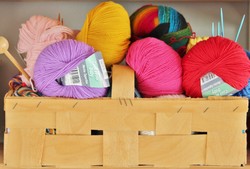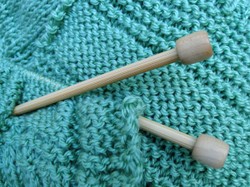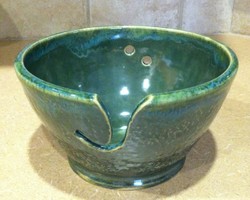There are plenty of patterns to start with and the classic one is a scarf. You also can't go wrong with a wash cloth, tea towel or pot holder.
Easy Scarf Pattern
For a 60 inch scarf you'll first want to get yourself 3 skeins of worsted weight yarn (see above for some assorted variations) and size US 8 or 5.0 mm needles.
Start by using the long tail cast on method and put 40 stitches on your working needle. With the knit and purl stitches you can create at least four different patterns for your scarf:
- Garter stitch: knit every stitch on both right and wrong sides
- Stockinette stitch: knit every stitch on the right side and purl every stitch on the wrong side
- Seed stitch: alternate between knit and purl on right side and then swap to alternating purl and knit on the wrong side
- Ribbing: usually done in 1x1, 2x2, or 4x4 meaning 1 knit and 1 purl then repeat until the end; 2 knit then 2 purl then repeat until the end; 4 knit and 4 purl then repeat until the end.
Carry on in your preferred stitch pattern until you reach approximately 60 inches and then follow the bind off and blocking instructions below.
Wash Cloth or Tea Towel
Both of these are very similar to the scarf just smaller. You will want to switch to a US size 6 or 4 mm and a double knit (DK) weight yarn which is a little lighter. With these two items you can cast on as many stitches as you like and keep going back and forth until you have your desired length.
Pot Holder
Making a pot holder can be a little tricky as you will want to make sure that the finished product is thick enough so as not to burn you or through to any surface the pot is sat on.
I would recommend choosing a thicker wool such as worsted or chunky and either double up the yarn whilst you are knitting or make double the length and fold in half and sew together if you wanted to put a heat resistance material in between.






 What Is INRon 03/11/2017
What Is INRon 03/11/2017
 What is Factor V Leiden Genetic Mutationon 08/05/2013
What is Factor V Leiden Genetic Mutationon 08/05/2013
 Increasing Fiber For Optimum Healthon 07/24/2013
Increasing Fiber For Optimum Healthon 07/24/2013
 Bobski606's Wizzographyon 02/23/2013
Bobski606's Wizzographyon 02/23/2013



Feedback And Thoughts
Thanks Frank, I'll check out that article on male knitting.
Yes. In a land that made its living from wool and cotton, there were males who earned from the wool business. Before industrialization whole families were involved in textiles, weaving and making woolens at home, and men and women did the same tasks. How many men knitted I know not, but when they did it would be woolens for sale.
Just type in Bros and Rows for an article in The Huffington Post about the history of male knitting. In mediaeval England there were craft guilds of male knitters, something that I discovered in that article.
Deep down many males yearn to do peaceful, creative activities and be free from the expectations that you must be macho and competitive to be male, and knitting is one such activity that fits the bill very well.
@ frankbeswick, I didn't know that fact of men knitting in the 18th century. I believe it male knitters are starting to make a come back again though from the youtube videos and other blogs that I follow.
A related skill is darning,in which a patch in a woolen garment is mended with strands of wool. My mother darned many of our clothes.
Men knitting was not unusual, for in the late eighteenth and early nineteenth centuries English males wove and knitted. There were very many men involved in textiles made of cotton and wool. Only as the nineteenth century progressed and sex roles become more stereotypical did knitting come to be seen as essentially female task.
I love that people all ages are knitting these days, and even men and boys! I am just finishing up an article on one of my blogs about how good knitting is for lowering blood pressure, and relieving stress.
Handmade yarn gifts are treasures to keep and pass down through generations.
We know that my grand-daughter liked the scarf as when my wife wears it, Sophie reaches out for it and takes it to play with.
Yes indeed. I love knitting I don't do fancy things but people like what I make. I made a scarf for Frank Beswick's wife and she loved it so much. Frank's granddaughter aged 18 months loved it too so I made her one for Christmas.
Every Fall/ Autumn I knit hats scarfs and mittens for my grand children to see them through winter.
Our mother taught me.
This article brings back memories! My mother was keen on knitting, and she made many clothes for us by using this skill, all made by hand without a knitting machine. For a not well off working class family, her knitting was a blessing, as it saved so much money that would otherwise have had to be spent on purchasing clothes.
Thanks for stopping by dustytoes, I love using the long tail cast on method and find it the easiest one to use.